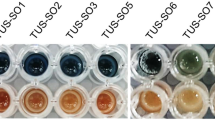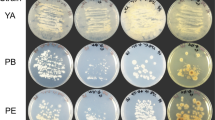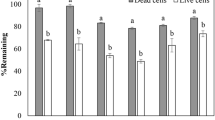Abstract
STUDIES of the microbial decomposition of anthranilic acid have been confined mostly to work with various strains of Pseudomonas spp.1–3 which oxidize anthranilic acid to catechol by an unknown pathway. The role of salicylic acid in this conversion is not clear since reported experiments based on the technique of simultaneous adaptation have yielded divergent results1,4. Sakamoto et al.4 have further shown that cell suspensions, adapted to oxidize anthranilic acid, are inactive towards 3-hydroxyanthranilic acid and 5-hydroxyanthranilic acid. By contrast, the two last-named compounds have been clearly implicated in the breakdown of anthranilic acid by mammalian tissue since both have been isolated from the urine of animals injected with anthranilic acid or o-aminobenzamide5–9.
This is a preview of subscription content, access via your institution
Access options
Subscribe to this journal
Receive 51 print issues and online access
$199.00 per year
only $3.90 per issue
Buy this article
- Purchase on Springer Link
- Instant access to full article PDF
Prices may be subject to local taxes which are calculated during checkout
Similar content being viewed by others
References
Suda, M., Hayaishi, O., and Oda, Y., J. Biochem., Japan, 37, 355 (1950).
Hayaishi, O., and Stanier, R. Y., J. Bact., 62, 691 (1951).
Stanier, R. Y., and Hayaishi, O., J. Bact., 62, 367 (1951).
Sakamoto, Y., Uchida, M., and Ichihara, K., Med. J. Osaka Univ., 3, 477 (1953).
Bray, H. G., Lake, H. F., Neale, F. C., Thorpe, W. V., and Wood, P. B., Biochem. J., 42, 434 (1948).
Shirai, Y., J. Japan. Biochem. Soc., 22, 223 (1950).
Shirai, Y., and Uno, S., J. Japan. Biochem. Soc., 23, 51 (1951).
Kotake, Y., Shibata, Y., and Toratani, A., Proc. Japan. Acad., 32, 774 (1956).
Hagihara, F., and Okazaki, Y., J. Pharm. Soc., Japan, 76, 362 (1956).
Ladd, J. N., Austral. J. Biol. Sci. (in the press).
Ke, Y., Gee, L. L., and Durham, N. N., J. Bact., 77, 593 (1959).
Author information
Authors and Affiliations
Rights and permissions
About this article
Cite this article
LADD, J. Oxidation of Anthranilic Acid by a Species of Achromobacter isolated from Soil. Nature 194, 1099–1100 (1962). https://doi.org/10.1038/1941099b0
Issue Date:
DOI: https://doi.org/10.1038/1941099b0
This article is cited by
-
Gentisate-1,2-dioxygenase activity by an iron(II)-phenanthroline complex
Journal of Chemical Sciences (2018)
-
Anthranilic acid metabolism by microorganisms. Formation of 5-hydroxyanthranilate as an intermediate in anthranilate metabolism byNocardia opaca
Antonie van Leeuwenhoek (1968)
Comments
By submitting a comment you agree to abide by our Terms and Community Guidelines. If you find something abusive or that does not comply with our terms or guidelines please flag it as inappropriate.



